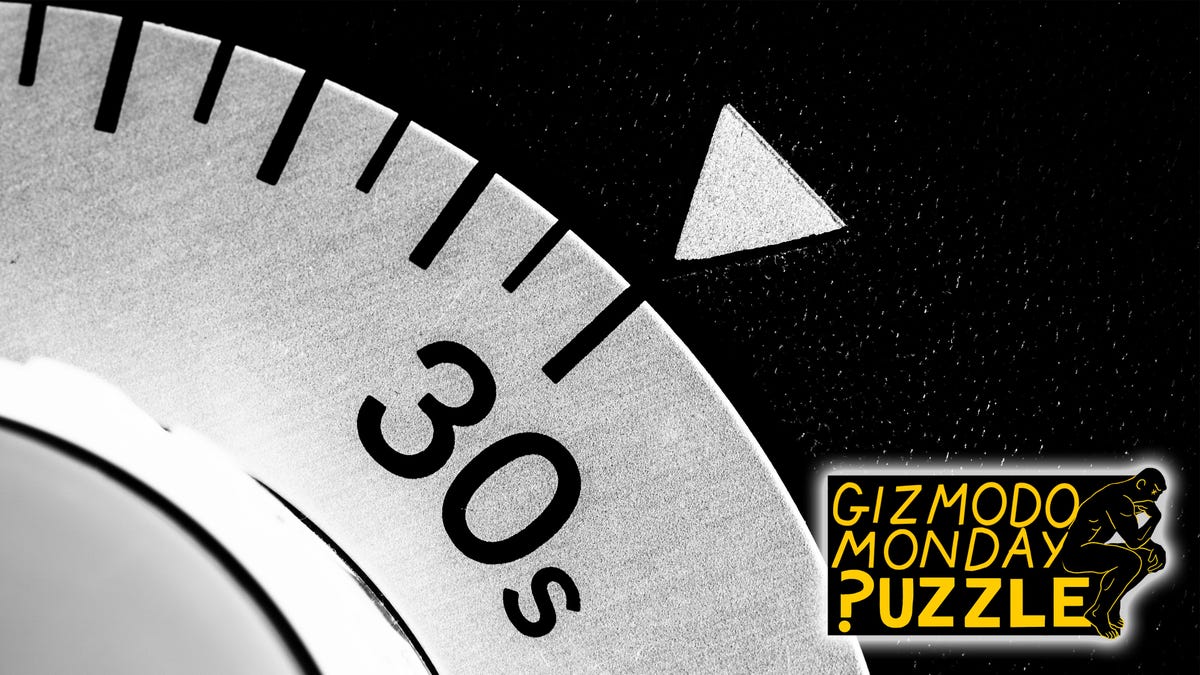Before you accuse me of clickbait, hear me out. If you scroll the same corners of social media that I do, then you’re sick of seeing meme puzzle accounts abuse the caption “Only 1% of people can solve!” over some lightweight teasers. Are we really supposed to believe that only 1 in 100 people can count the triangles in an image? Or that “Only GENIUSES” remember basic arithmetic? The headlines are insulting. But it’s different when I do it.
This week’s puzzles come from a British game show called The 1% Club, in which contestants compete for money by solving increasingly difficult brainteasers. The show ranks the puzzles based on real public surveys, and each episode culminates with a challenge that only 1% of the population could solve. Two seasons have aired with a third on the way, as well as an upcoming American adaptation hosted by Patton Oswalt. I’m not getting paid for these plugs; I’m just a fan of the show, and if you follow The Gizmodo Monday Puzzle then you’ll probably like it too.
I’ll give you some example questions from the show to give you a sense of their style. I’ve put the answers below the main puzzle, so beware of scrolling if you’d like to solve these first.
Example 1 (35% Question): What number do you get if you multiply all the numbers on a telephone keypad together?
Example 2 (15% Question): Which animal is half goat and one third cow?
Example 3 (10% Question): Which is the odd one out? TROJAN, DISMAY, TRANSEPT, CONCOCT, JUSTIFY
Did you miss last week’s puzzle? Check it out here, and find its solution at the bottom of today’s article. Be careful not to read too far ahead if you haven’t solved last week’s yet!
Puzzle #40: 1% Questions
Bonus challenge: Players on the show only get 30 seconds to solve each puzzle, so pull out a stopwatch if you want to simulate the real experience. I expect most people will need more time than that.
Question 1: In the following sequence, what do the letters V and C stand for?
V C C C V C C C V C C C C C V C C C C C V C C C C C
Question 2: On a digital 24-hour clock (military time) that displays hours, minutes, and seconds, how many times in each 24-hour period do all six digits change simultaneously?
Question 3:
Jamaica + Japan = 124
Argentina + Armenia = 1245
France + Brazil = 23
England + Germany = ?
I’ll be back next Monday with the answers to the 1% questions and a new puzzle. Do you know a cool puzzle that you think should be featured here? Message me on X @JackPMurtagh or email me at [email protected]
Answers to the example questions below.
Example 1 (35% Question): What number do you get if you multiply all the numbers on a telephone keypad together?
Zero. Recall that phone keypads have zeroes on them!
Example 2 (15% Question): Which animal is half goat and one third cow?
Cat. The word “cat” uses half of the letters in “goat” (“at”) and one third of the letters in “cow” (“c”).
Example 3 (10% Question): Which is the odd one out? TROJAN, DISMAY, TRANSEPT, CONCOCT, JUSTIFY
JUSTIFY is the odd one out. All of the others end in a month abbreviation (JAN, MAY, SEPT, OCT).
Solution to Puzzle #39: A Self-Referential Number
Last week’s puzzle asked you to find a number that describes itself. Shout-out to Kelly who submitted the correct answer to this and the bonus puzzle by email.
Only one 10-digit number has the following property. Its left-most digit is the number of 0s in the number, the next digit is the number of 1s in the number, the next is the number of 2s, and so on until the right-most digit, which is the number of 9s in the number. Find the number.
The answer is 6210001000. It contains six 0s, two 1s, one 2, and one 6. This is the largest self-referential number by our definition and the only 10-digit one. The full list is: 1210, 2020, 21200, 3211000, 42101000, 521001000.
Thanks to Enfy for pointing out that I didn’t need to stipulate that numbers cannot begin with zero. The first digit of a self-referential number can never be zero because that would cause an immediate contradiction: it would imply that the number contained zero 0s and yet we would have just started with a zero.
The bonus puzzle was to find the only starting number for the look-and-say sequence that does not cause it to diverge to infinity. The answer is 22. The next number would describe 22 as “two 2s,” which would just be another 22, so the whole sequence would be 22, 22, 22, 22, …

